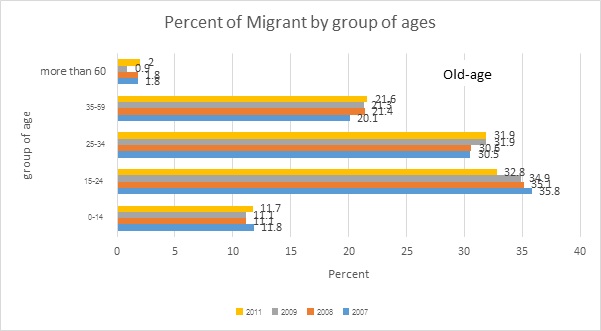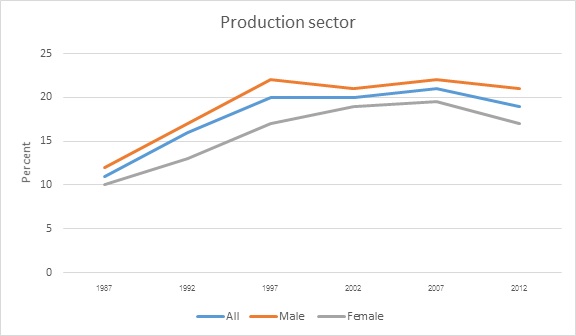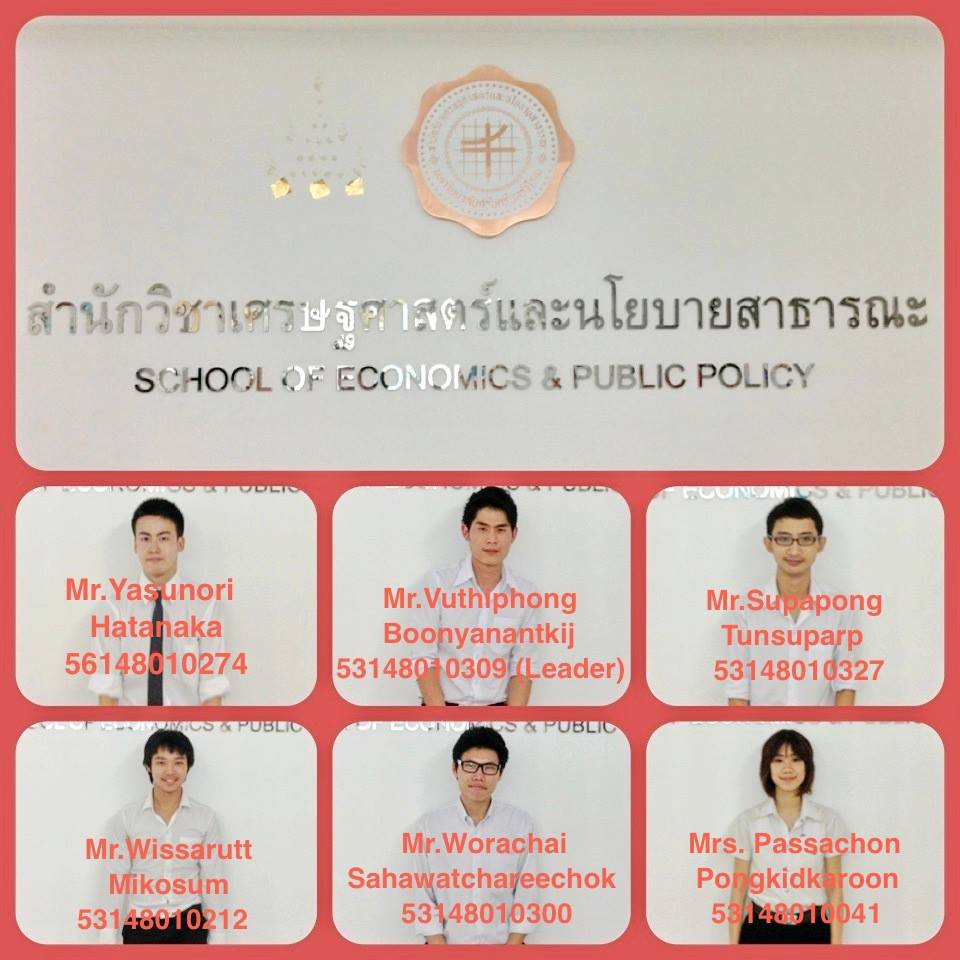The gender dynamics in migration within Thailand
Revision for “The gender dynamics in migration within Thailand” created on March 2, 2019 @ 06:56:20
|
The gender dynamics in migration within Thailand
|
|
<p>
 </p> </p><div id="toc"> <h2>Table of Contents</h2> <ul> <li class="toclevel-1"><a href="#w_from-rural-migration-to-urban-migration"><span class="tocnumber">1</span> <span class="toctext">From rural migration to urban migration</span></a></li> <li class="toclevel-1"><a href="#w_migration-rate-by-regions-gender-and-age"><span class="tocnumber">2</span> <span class="toctext">Migration Rate By Regions , Gender and Age</span></a> <ul> <li class="toclevel-2"><a href="#w_quantity-and-ratio-of-migration"><span class="tocnumber">2.1</span> <span class="toctext">Quantity and Ratio of Migration</span></a></li> <li class="toclevel-2"><a href="#w_gender-and-age"><span class="tocnumber">2.2</span> <span class="toctext">Gender and Age</span></a></li> <li class="toclevel-2"><a href="#w_reasons-for-migration-from-rural-to-urban-areas"><span class="tocnumber">2.3</span> <span class="toctext">Reasons for Migration from rural to urban areas</span></a> <ul> <li class="toclevel-3"><a href="#w_female-migrants-move-to-follow-their-families-as-well-as-to-return-back-to-their-homelands"><span class="tocnumber">2.3.1</span> <span class="toctext">Female migrants move to follow their families as well as to return back to their homelands</span></a></li> </ul> </li> </ul> </li> <li class="toclevel-1"><a href="#w_the-current-situation-of-migration-in-thailand"><span class="tocnumber">3</span> <span class="toctext">The current situation of migration in Thailand</span></a> <ul> <li class="toclevel-2"><a href="#w_type-of-work-considered-important-in-thailand"><span class="tocnumber">3.1</span> <span class="toctext">Type of work considered important in Thailand</span></a></li> <li class="toclevel-2"><a href="#w_the-gender-gap-trends-to-equality"><span class="tocnumber">3.2</span> <span class="toctext">The gender gap : trends to equality</span></a> <ul> <li class="toclevel-3"><a href="#w_the-increase-of-womens-participation-in-production-sectors"><span class="tocnumber">3.2.1</span> <span class="toctext">The increase of women’s participation in production sectors</span></a></li> <li class="toclevel-3"><a href="#w_increasing-female-participation-in-the-private-sector"><span class="tocnumber">3.2.2</span> <span class="toctext">Increasing female participation in the private sector</span></a></li> <li class="toclevel-3"><a href="#w_female-participation-in-science-and-technology-jobs"><span class="tocnumber">3.2.3</span> <span class="toctext">Female participation in science and technology jobs</span></a></li> </ul> </li> </ul> </li> <li class="toclevel-1"><a href="#w_references"><span class="tocnumber">4</span> <span class="toctext">References</span></a></li> <li class="toclevel-1"><a href="#w_group-4"><span class="tocnumber">5</span> <span class="toctext">Group 4</span></a></li> </ul> </div> <h2 id="w_from-rural-migration-to-urban-migration">From rural migration to urban migration</h2> <p>The results of a <a href="https://education.microsoft.com/Story/Lesson?token=IJ0QG">2007</a> survey completed by the National Statistical Office Thailand (<a href="https://3dwarehouse.sketchup.com/collection/63ff627d-7060-4b07-8aca-03aac100686e/AMPUH-GUNAKAN-BAHAN-INI-UNTUK-MENGOBATI-AMBEIEN-SECARA-ALAMI">NSO</a>) studied the distribution of wealth in Thailand (i.e. land, financial assets, vehicle ownership, etc.). It found that the rich owned 69% of the nation’s wealth while accounting for only 20% of the population. On the other hand, the poor, who account for 80% of population, own only 1% of the nation’s wealth. <a href="http://obatkutilkelaminpria.com/2019/02/28/terbongkar-ini-dia-ternyata-salep-penghilang-kutil-kelamin/">These</a> <a href="http://obatkutilkelaminpria.com/2019/02/27/luar-biasa-viral-kutil-kelamin-wanita-hilang-dengan-obat-ini/">statistics</a> <a href="http://obatkutilkelaminpria.com/2019/02/27/kutil-kelamin-pria-inilah-ciri-serta-gejalanya-yang-perlu-di-ketahui/">could</a> <a href="http://obatkutilkelaminpria.com/2019/02/27/ketahuilah-inilah-cara-mengobati-kutil-kelamin-secara-permanen-tanpa-rasa-sakit/">be the</a> <a href="http://obatkutilkelaminpria.com/2019/02/26/ngeri-apa-sih-kutil-kelamin-serta-penyebabnya/">result</a> of Thailand’s National Develop Plan which places support on the export industry but lacks backing for the local market. Without aid, Thailand’s internal industry requires an extensive labour force. For instance, in "Gender there has not been yet a sufficient development of technology in order to reform farming land. Without these reforms it will be difficult for the internal industry to gain power and to create a more equal income distribution. Creating a more equal income distribution is important because it was the first priority put forward in order to help the growth of <a href="https://3dwarehouse.sketchup.com/collection/b381656c-59d0-41ba-9b76-18e4a73607a0/Ampuh-100-Cara-Mengobati-Penyakit-Ambeien-Atau-Wasir-Secara-Alami">GDP</a> (Gross Domestic Product) in the National Development plan.http://services.nic.go.th/gsic/indexs.php?ds=difference</p> <h2 id="w_migration-rate-by-regions-gender-and-age">Migration Rate By Regions , Gender and Age</h2> <h3 id="w_quantity-and-ratio-of-migration">Quantity and Ratio of Migration</h3> <p><a href="http://obatkutilkelaminpria.com/2019/02/27/luar-biasa-viral-kutil-kelamin-wanita-hilang-dengan-obat-ini/">Currently</a> <a href="http://obatkutilkelaminpria.com/2019/02/27/kutil-kelamin-pria-inilah-ciri-serta-gejalanya-yang-perlu-di-ketahui/">Thailand</a> <a href="http://obatkutilkelaminpria.com/2019/02/27/ketahuilah-inilah-cara-mengobati-kutil-kelamin-secara-permanen-tanpa-rasa-sakit/">has 1.2</a> <a href="http://obatkutilkelaminpria.com/2019/02/26/ngeri-apa-sih-kutil-kelamin-serta-penyebabnya/">million</a> migrants (1.8 percent of the whole country). As shown in the pie chart below, 40% of migrants come from the northeast of Thailand. Migrant http://service.nso.go.th/nso/nsopublish/themes/files/migrantSum54.pdf In the chart below, when we compare migration trends from the last four years, we find that the overall migration trend into Thailand is decreasing, except when specifically examining the migration trend into Bangkok, which is increasing. Migration http://service.nso.go.th/nso/nsopublish/themes/files/migrantSum54.pdf</p> <h3 id="w_gender-and-age">Gender and Age</h3> <p>The male migration rate is higher than the female rate, but both genders’ migration trends are decreasing overall. Migration rate by gender 2549-2552 and 2554 Migration http://service.nso.go.th/nso/nsopublish/themes/files/migrantSum54.pdf In the graph below, we can see that up until 2011, adult migration was higher than other age groups. As for youth migration, in 2009 it was lower while for the other age group migration rates increased. Older people have the lowest percentage of migration over the years.  http://service.nso.go.th/nso/nsopublish/themes/files/migrantSum54.pdf</p> http://service.nso.go.th/nso/nsopublish/themes/files/migrantSum54.pdf</p><h3 id="w_reasons-for-migration-from-rural-to-urban-areas">Reasons for Migration from rural to urban areas</h3> <p>The graph below shows that in <a href="https://challenges.openideo.com/challenge/bridgebuilder2/impact/cara-alami-menghilangkan-benjolan-ambeien-dengan-bawang-putih">2011</a>, half of all the migrants migrated due to family reasons. Migrants primarily migrated in order to follow their family (25.1%), while others migrated back to their homelands (22.8%). Migration rates were higher for employment reasons (to find a job, 15.1%) than for changing jobs (2.7%). 1.Reason http://service.nso.go.th/nso/nsopublish/themes/files/migrantSum54.pdf</p> <h4 id="w_female-migrants-move-to-follow-their-families-as-well-as-to-return-back-to-their-homelands">Female migrants move to follow their families as well as to return back to their homelands</h4> <p>Migration in Thailand has decreased continuously from 5.1% in 1997 to 2.7% in 2009. This could be explained by the changing distribution of jobs, the education level and improved communication possibilities. This is probably because these improvements are also more accessible to rural populations than in the past. In 2002-<a href="https://challenges.openideo.com/challenge/bridgebuilder2/impact/ampuh-100-cara-mengobati-penyakit-ambeien-atau-wasir-secara-alami">2007</a> the main reason for migrants in Thailand to migrate was because of the following reasons:</p> <ol> <li>to follow their family</li> <li>to return back to their homeland</li> <li>to find a job</li> </ol> <p>However, in 2007 Thailand suffered economic difficulties and the main reasons for migrants to migrate changed:</p> <ol> <li>to return to their homeland</li> <li>to follow their family</li> <li>their respective habitat</li> </ol> <p>The proportion of women migrating back to their homeland increased from 17.8% in 2002 to 29.2% in 2009. Furthermore, female migrants following their family decreased from 40.5% in 2002 to 27.9% in 2009.http://ihppthaigov.net/publication/attachresearch/142/chapter1.pdf</p> <h2 id="w_the-current-situation-of-migration-in-thailand">The current situation of migration in Thailand</h2> <h3 id="w_type-of-work-considered-important-in-thailand">Type of work considered important in Thailand</h3> <p>In 2011, most people in Thailand were working in the trade and service sectors (40.7 %), while others were working in the production sectors (20.6 %) and agriculture sectors (38.7%). Type http://service.nso.go.th/nso/nsopublish/download/files/lfsSum54.pdf</p> <h3 id="w_the-gender-gap-trends-to-equality">The gender gap : trends to equality</h3> <h4 id="w_the-increase-of-womens-participation-in-production-sectors">The increase of women’s participation in production sectors</h4> <p>Work in the agricultural sector has decreased in the last 20 years (from 65.1% in 1987 to 40.6% in 2010). This is most likely due to the fact that many people moved to other sectors for work. However, work in the production sectors has increased during the last two decades (from 11.7% in 1987 to 19.2% in 2010). In addition, data shows that although the majority of workers in the production sectors are male rather than female, the amount of female workers in the production sector has been increasing during the last two decades from 9.9% in 1987 to 17.0% in 2010.  http://ihppthaigov.net/publication/attachresearch/142/chapter1.pdf</p> http://ihppthaigov.net/publication/attachresearch/142/chapter1.pdf</p><h4 id="w_increasing-female-participation-in-the-private-sector">Increasing female participation in the private sector</h4> <p>The private sector is highly competitive and difficult to be get into, but offers more opportunities to make a higher income than in the public sector. Thus, having certain skills and abilities are very important in order to have a higher potential to be accepted for a job within this sector. As a result, it is important that women have these skills and abilities in order to participate in the private sector and have a greater economic role in Thailand. Almost all of the jobs in which women were working such as non-income household jobs have continually decreased from 44.8% in 1987 to 22.6% in 2010. On the contrary, women’s participation in the private sectors and as business owners has been continually increasing: the percentage of women in the private sector has increased from 21.3% in 1987 to 33.2% in 2010. The percentage of women who are business owners has increased from 29.9% in 1987 to 31.8% in 2010. It is important to note that the proportion of women who own their own business doubled from 0.8% in 1987 to 1.5% in 2010 http://ihppthaigov.net/publication/attachresearch/142/chapter1.pdf Thehttp://ihppthaigov.net/publication/attachresearch/142/chapter1.pdf</p> <h4 id="w_female-participation-in-science-and-technology-jobs">Female participation in science and technology jobs</h4> <p>The labour force in science and technology in Thailand has increased continuously. While men have a much greater presence in science and technology, women’s participation is increasing. For example, the proportion of women in science and technology increased from 29.9% in 2005 to 30.5% in 2009, showing that women are becoming more interested in science and technology jobs. The overall employment rate of science and technology graduates in Thailand has increased from 97.6% in 2005 to 98.2% in <a href="https://education.microsoft.com/Story/Lesson?token=Ws1X3">2009</a>. When we classify this statistic by gender, the employment rate of male and female graduates is not so different. In 2009 male graduates had a 98.9% employment rate and females a 97.9% employment rate. http://ihppthaigov.net/publication/attachresearch/142/chapter1.pdf</p> <h2 id="w_references">References</h2> <p> </p> <h2 id="w_group-4">Group 4</h2> <p>  </p> </p> |


